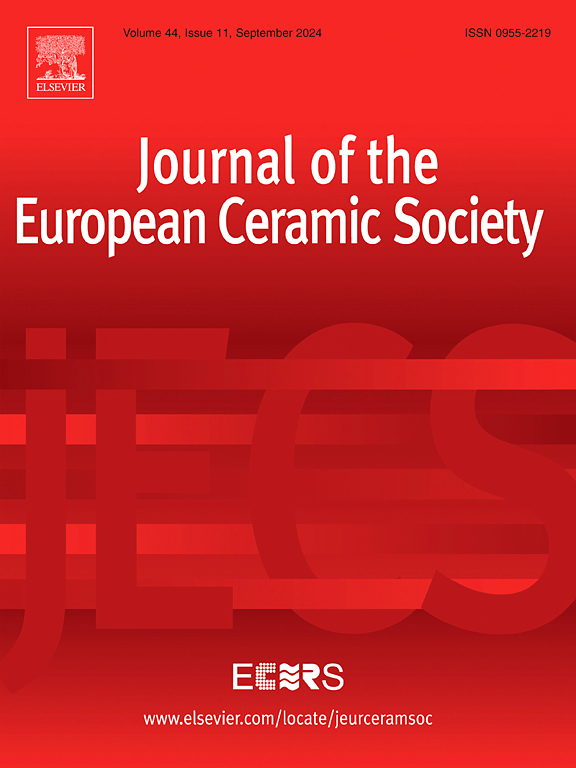High temperature stability in Li2CO3-doped PYN-PZT co-fired multilayer piezoelectric actuators
IF 6.2
2区 材料科学
Q1 MATERIALS SCIENCE, CERAMICS
Journal of The European Ceramic Society
Pub Date : 2025-06-06
DOI:10.1016/j.jeurceramsoc.2025.117601
引用次数: 0
Abstract
Improving the performance stability of piezoelectric ceramic materials over a wide temperature range, especially at high temperatures, is a challenge and a research hotspot. In this study, the outstanding piezoelectric, dielectric, and ferroelectric properties of 0.15Pb(Yb1/3Nb2/3)O3-0.37PbZrO3-0.48PbTiO3 (PYN-PZT) ceramics are achieved by introducing the sintering additive Li2CO3. These ceramics achieved excellent performance (d33 = 459 pC/N, d33* = 573 pm/V, TC = 401 °C) at 1100 °C, which enables co-firing with the internal electrode. Furthermore, they demonstrate excellent temperature stability (Variation = 5.84 %) over a wide temperature range (30–190 °C). Subsequently, PYN-PZT+ 0.05Li multilayer piezoelectric actuators (MLAs), with dimensions of 7 × 7 × 36 mm, were fabricated using the tape casting method. The PYN-PZT+ 0.05Li-MLAs exhibit superior performance (S = 0.0689 %) and temperature stability (Variation = 9.87 %) across the temperature range (30–190 °C) and retain 88.5 % of their performance at 270 °C. The service temperature and temperature stability are significantly higher than those of previously reported materials and commercial actuators, suggesting that the PYN-PZT+ 0.05Li-MLAs hold great promise for significantly expanding the high-temperature range of MLAs.
li2co3掺杂PYN-PZT共烧多层压电致动器的高温稳定性
提高压电陶瓷材料在宽温度范围内,特别是高温下的性能稳定性是一个挑战和研究热点。本研究通过引入烧结添加剂Li2CO3,实现了0.15Pb(Yb1/3Nb2/3)O3-0.37PbZrO3-0.48PbTiO3 (PYN-PZT)陶瓷优异的压电、介电和铁电性能。这些陶瓷在1100℃下获得了优异的性能(d33 = 459 pC/N, d33* = 573 pm/V, TC = 401°C),可以与内部电极共烧。此外,它们在宽温度范围(30-190°C)内表现出优异的温度稳定性(变化= 5.84 %)。随后,采用带铸法制备了尺寸为7 × 7 × 36 mm的PYN-PZT+ 0.05Li多层压电致动器(MLAs)。PYN-PZT+ 0.05Li-MLAs在温度范围(30-190°C)内表现出优异的性能(S = 0.0689 %)和温度稳定性(变化= 9.87 %),在270°C下保持88.5 %的性能。使用温度和温度稳定性明显高于先前报道的材料和商用促动器,这表明PYN-PZT+ 0.05Li-MLAs在显着扩大MLAs的高温范围方面具有很大的前景。
本文章由计算机程序翻译,如有差异,请以英文原文为准。
求助全文
约1分钟内获得全文
求助全文
来源期刊

Journal of The European Ceramic Society
工程技术-材料科学:硅酸盐
CiteScore
10.70
自引率
12.30%
发文量
863
审稿时长
35 days
期刊介绍:
The Journal of the European Ceramic Society publishes the results of original research and reviews relating to ceramic materials. Papers of either an experimental or theoretical character will be welcomed on a fully international basis. The emphasis is on novel generic science concerning the relationships between processing, microstructure and properties of polycrystalline ceramics consolidated at high temperature. Papers may relate to any of the conventional categories of ceramic: structural, functional, traditional or composite. The central objective is to sustain a high standard of research quality by means of appropriate reviewing procedures.
 求助内容:
求助内容: 应助结果提醒方式:
应助结果提醒方式:


